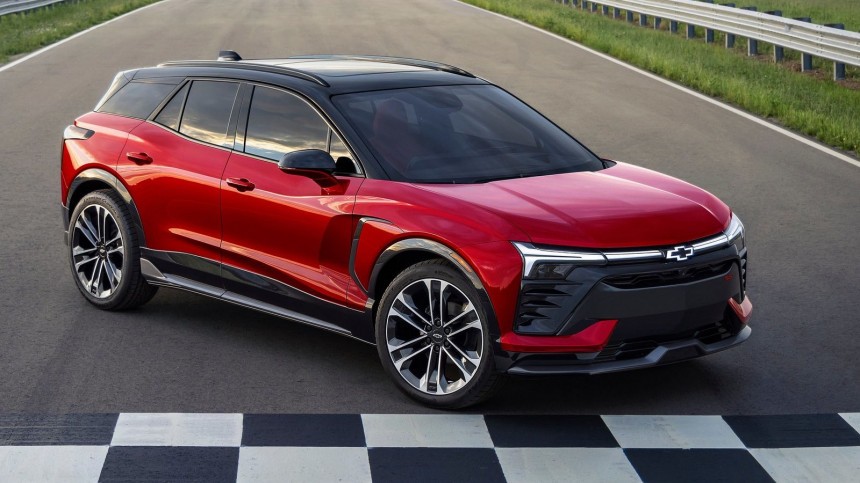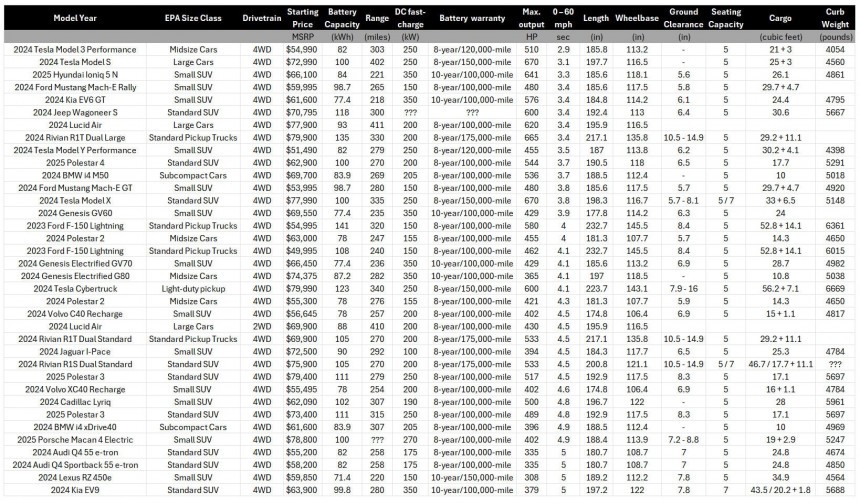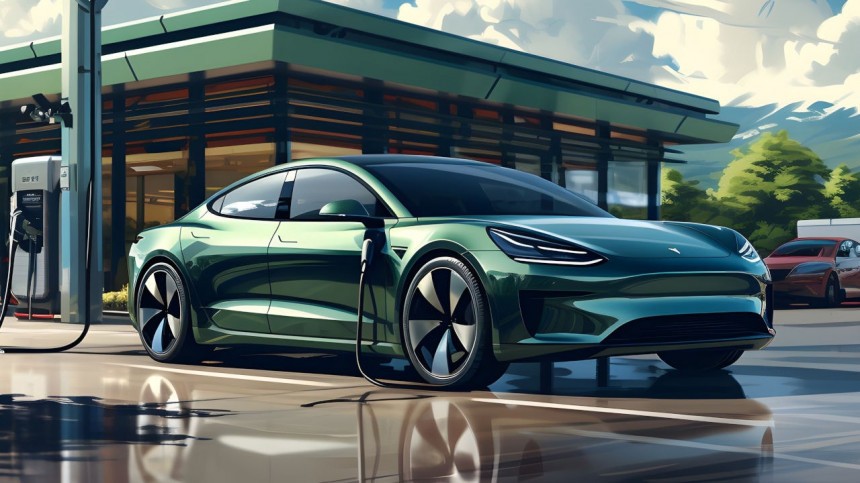According to the most recent data from Cox Automotive, June's average transaction price for new cars is around $47,500. This means many Americans buy vehicles that cost more or a lot more than the psychological $50,000 bar. Let's see if EVs costing more than that are a good deal or not.
A short recap: shall we? In the first part of this series, I gave you a list of around 60 electric models you can buy right now in America. Then, in the second part, I analyzed the few EVs costing less than $40,000, while in the third part, I shared some thoughts on the EVs in the $40-50,000 price range.
Now, it's time to see what's going on in the realm of more expensive EVs than $50,000. Of course, we should first consider cars with an MSRP starting price of less than $80,000, the limit at which you can benefit from the $7,500 EV tax credit.
Did you expect just a bunch of models and variants? You're wrong; the $50-80,000 price range counts more than 60 total powertrains and battery combinations. This hints that expensive EVs have more advantages than previously thought and are much more challenging for their ICE and hybrid counterparts.
You can also notice that this is where electric models from established premium brands emerge. And, of course, most of them are SUVs, while the 4WD variants prevail. Unsurprisingly, half of the cars on this list have MSRP prices under the $60,000 bar, so the competition is fierce.
Unfortunately, the average range is just 280 miles, still less than 300 miles, which is a bummer for the average price of around $63,000. I should also note that the average range for the cars in the less expensive $50-60,000 price range is only 275 miles—this is only 5 miles better than the average of cars in the $40-50,000 price range! That's not good news, for sure.
Of course, these more expensive cars are also bigger and heavier. For instance, the average weight is more than 5,100 lbs, and the average length is around 192 in. To give you a perspective on this, these values are similar to those of the Chevrolet Blazer, one of the newest and very promising EV-kids on the block.
I'll let you find that example in the table below, where I ranked the cars with a maximum acceleration of 5 seconds for the 0-60 mph sprint. Gosh, I didn't expect half of them to be quicker than 4 seconds! Especially since most of those are closer to the $60,000 bar than the $80,000 one.
I think that we can all agree that a less-than-5-second sprint to 60 mph is not a sports car trait anymore, thanks to electric motors. Who needs a roaring Lambo Huracan, costing an arm and a leg at around $250,000 and sprinting in just 2.5 seconds to 60 mph when a 4-door electric sedan is capable of 2.9 seconds for four times less money?
You could throw in my face the less-than-4 seconds the Ford F-150 Raptor R needs to get to 60 mph, and I'll reply that its electric sibling, the Lightning, requires just a few tens of miliseconds for several tens of thousands less. We could go on with many such examples, and I guarantee that most comparisons would favor electric cars.
The bottom line is that performance is a silent driving factor in EVs' progressive takeover of the more than $50,000 car market. Many people who can afford expensive cars take a different approach to long journeys. For instance, using a plane to travel from A to B is more cost-effective and convenient than driving for hundreds or thousands of miles.
Of course, popular wisdom states that many people who afford to buy a car north of the $50,000 bar don't give a damn about EVs' lower costs of ownership or their lack of pollution in usage. But maybe popular wisdom is wrong.
In fact, people who have more money (but not at the "filthy rich" level) better understand the value of the stuff they buy. Therefore, the advantages of lower electricity costs for the battery, the EV tax reducing the MSRP price, and the price/performance ratio are pretty serious reasons for these people to go for an electric vehicle.
Frankly, there's not much to say about the cars in the table above. The average MSRP price of around $120,000 sums is up – choosing one car or another is simply a matter of taste, as the budgetary constraints are less stringent. I'm not saying they don't exist, but they're totally different than those in lower price ranges.
It's futile for me to emphasize the Tesla Model S's 2-second sprint for a price only $4,000 higher than the BMW i5 M60 beast if you're not an Elon fan but a Bimmer enthusiast. The same goes for comparing the more agile BMW iX to the more stylish Benz EQS SUV—there's no objective choice to make here despite the pretty big price difference.
Still, I will highlight the improvement in the average range for the cars in this table: the value of around 325 miles might not be impressive for how expensive these cars are, but it's around 14% better than the average value for the vehicles in the $50-80,000 price range (which, I remind you, was just slightly better than for the $40-50,000 price range).
The same goes for the batteries: the average value for these cars' battery capacities is more than 120 kWh, 30% higher than for the cars under $80,000. In fact, most expensive cars here are fitted with 100+ kWh batteries and showcase ranges close to the 350-mile bar.
Going for an electric car costing around $90-100,000 (the final price will surely be much higher thanks to the variety of high-end optional equipment) will get you ranges much closer to their ICE counterparts. That's because, you know, larger internal combustion engines tend to be guzzlers, so their range also shrinks.
I tend to believe that, even if the range remains an issue (350 miles is acceptable at most), many electric luxury cars and SUVs today are better options than comparable ICE or hybrid vehicles. I wonder if the status symbol tips the scale in favor of EVs – being wealthy and driving a guzzler makes you a villain nowadays. That's not good for business, right?
Expect many of them to target the $35-40,000 price range, as economy of scale is the basis for the electric car industry's profitability. Of course, the real boost in sales and production will come once solid-state batteries become mainstream, but don't expect this to happen sooner than around 2030.
Until then, EVs' evolution will be somehow incremental, though those little steps are actually big leaps compared to the evolution of ICE vehicles. There you are; in this four-part series, I gave you the full mid-2024 list of the EVs you can buy in the US right now. I'm a little evil here, hoping that it could convince you to convert to an electrohead. Let me know if I succeeded.
Now, it's time to see what's going on in the realm of more expensive EVs than $50,000. Of course, we should first consider cars with an MSRP starting price of less than $80,000, the limit at which you can benefit from the $7,500 EV tax credit.
You can also notice that this is where electric models from established premium brands emerge. And, of course, most of them are SUVs, while the 4WD variants prevail. Unsurprisingly, half of the cars on this list have MSRP prices under the $60,000 bar, so the competition is fierce.
Unfortunately, the average range is just 280 miles, still less than 300 miles, which is a bummer for the average price of around $63,000. I should also note that the average range for the cars in the less expensive $50-60,000 price range is only 275 miles—this is only 5 miles better than the average of cars in the $40-50,000 price range! That's not good news, for sure.
Of course, these more expensive cars are also bigger and heavier. For instance, the average weight is more than 5,100 lbs, and the average length is around 192 in. To give you a perspective on this, these values are similar to those of the Chevrolet Blazer, one of the newest and very promising EV-kids on the block.
The performance factor baffles me
Can you imagine a 4WD SUV capable of only 3.5 seconds for 0-60 mph for less than $50,000? Certainly, you can't find such a high-performance ICE or hybrid SUV for this money. Oh, and if you're eligible for the EV tax, that price is less than $45,000. Of course, given that the range anxiety is not prohibitive…I'll let you find that example in the table below, where I ranked the cars with a maximum acceleration of 5 seconds for the 0-60 mph sprint. Gosh, I didn't expect half of them to be quicker than 4 seconds! Especially since most of those are closer to the $60,000 bar than the $80,000 one.
You could throw in my face the less-than-4 seconds the Ford F-150 Raptor R needs to get to 60 mph, and I'll reply that its electric sibling, the Lightning, requires just a few tens of miliseconds for several tens of thousands less. We could go on with many such examples, and I guarantee that most comparisons would favor electric cars.
The bottom line is that performance is a silent driving factor in EVs' progressive takeover of the more than $50,000 car market. Many people who can afford expensive cars take a different approach to long journeys. For instance, using a plane to travel from A to B is more cost-effective and convenient than driving for hundreds or thousands of miles.
Of course, popular wisdom states that many people who afford to buy a car north of the $50,000 bar don't give a damn about EVs' lower costs of ownership or their lack of pollution in usage. But maybe popular wisdom is wrong.
In fact, people who have more money (but not at the "filthy rich" level) better understand the value of the stuff they buy. Therefore, the advantages of lower electricity costs for the battery, the EV tax reducing the MSRP price, and the price/performance ratio are pretty serious reasons for these people to go for an electric vehicle.
Are you willing to pay more than $80,000 for a car but not choose an EV? You must be crazy!
The table below shows the most expensive new electric vehicles available in America today. Well, I should say the reasonably very expensive ones because it's of no use to bring into discussion EVs costing more than a quarter of a million dollars, is it?It's futile for me to emphasize the Tesla Model S's 2-second sprint for a price only $4,000 higher than the BMW i5 M60 beast if you're not an Elon fan but a Bimmer enthusiast. The same goes for comparing the more agile BMW iX to the more stylish Benz EQS SUV—there's no objective choice to make here despite the pretty big price difference.
Still, I will highlight the improvement in the average range for the cars in this table: the value of around 325 miles might not be impressive for how expensive these cars are, but it's around 14% better than the average value for the vehicles in the $50-80,000 price range (which, I remind you, was just slightly better than for the $40-50,000 price range).
The same goes for the batteries: the average value for these cars' battery capacities is more than 120 kWh, 30% higher than for the cars under $80,000. In fact, most expensive cars here are fitted with 100+ kWh batteries and showcase ranges close to the 350-mile bar.
Going for an electric car costing around $90-100,000 (the final price will surely be much higher thanks to the variety of high-end optional equipment) will get you ranges much closer to their ICE counterparts. That's because, you know, larger internal combustion engines tend to be guzzlers, so their range also shrinks.
What are the chances of you becoming an EV owner, after all?
In conclusion, at this moment, the EV market in the US is pretty crowded, and it's going to be more crowded as more competitors will arrive this year and the next one. Despite the "slower than expected demand" the industry is using today, the huge investments made in the last few years will only expand the production of electric vehicles.Expect many of them to target the $35-40,000 price range, as economy of scale is the basis for the electric car industry's profitability. Of course, the real boost in sales and production will come once solid-state batteries become mainstream, but don't expect this to happen sooner than around 2030.












